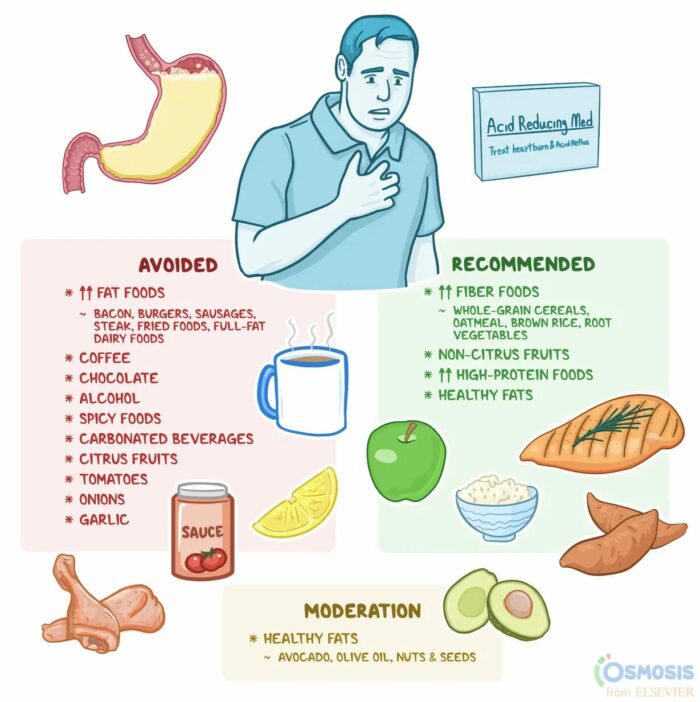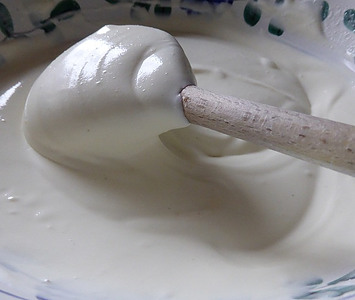Shopping for GERD Friendly Meals and grocery items is vital for those with persistent Acid Reflux. Creating a GERD-friendly shopping list is something that many will want to do that suffer from this condition. Knowing what foods to buy to help better manage this illness can go a long way on the road to remission.
GERD, or gastroesophageal reflux disease, is a chronic condition that affects millions of people worldwide. It occurs when the stomach acid flows back into the esophagus, causing symptoms such as heartburn, regurgitation, and chest pain.
Managing GERD requires making lifestyle changes, including following a GERD-friendly diet. Grocery shopping plays a crucial role in managing GERD symptoms as it allows individuals to choose foods that are less likely to trigger acid reflux.
In this article, we shall look to explore some of the best GERD Friendly Shopping Ideas.
Shopping for GERD-Friendly Meals: What To Buy?

GERD is a condition that occurs when the lower esophageal sphincter (LES), a muscle that acts as a valve between the stomach and the esophagus, does not close properly.
This allows stomach acid to flow back into the esophagus, causing irritation and inflammation. There are several factors that can contribute to the development of GERD, including obesity, hiatal hernia, and certain lifestyle habits such as smoking and consuming alcohol.
Certain foods and beverages can trigger or worsen GERD symptoms. Common triggers include fatty foods, spicy foods, citrus fruits, chocolate, caffeine, and carbonated beverages.
It is important for individuals with GERD to identify their personal triggers and avoid them as much as possible.
Following a GERD-friendly diet can help reduce symptoms and improve quality of life.
Creating a GERD-Friendly Shopping List: Some Ideas
When creating a shopping list for managing GERD, it is important to include foods that are less likely to trigger acid reflux and avoid or limit foods that can worsen symptoms.
Whole grains such as oatmeal, brown rice, and whole wheat bread are excellent choices for individuals with GERD as they are high in fiber and low in fat.
Lean proteins such as skinless poultry, fish, and tofu are also recommended.
Fruits and vegetables are an essential part of a GERD-friendly diet.
However, it is important to choose fruits and vegetables that are less likely to trigger symptoms.
Bananas, melons, and leafy greens are generally well-tolerated by individuals with GERD. But on the other hand, fatty and spicy foods should be avoided or limited as they can relax the LES and increase the risk of acid reflux.
Navigating the Aisles: Tips for Finding GERD-Friendly Groceries
When grocery shopping for GERD-friendly products, it is important to read food labels carefully. Look for low-acid canned goods such as tomatoes and tomato products that have been processed to reduce acidity.
Opt for whole grain products such as whole wheat pasta and brown rice instead of refined grains.
Choose low-fat or fat-free dairy products and avoid or limit high-fat options.
In the produce aisle, choose fruits and vegetables that are less likely to trigger symptoms. Opt for bananas, melons, and leafy greens instead of citrus fruits and tomatoes.
When it comes to proteins, choose lean options such as skinless poultry, fish, and tofu.
Avoid or limit fatty meats and processed meats such as deli meats, bacon, and hot dogs.
Choosing the Right Proteins: Lean Options for GERD Sufferers
Proteins are an essential part of a healthy diet, but certain protein sources can trigger or worsen GERD symptoms. It is important for individuals with GERD to choose lean protein options that are less likely to cause acid reflux.
Skinless poultry such as chicken and turkey are excellent choices as they are low in fat. Fish, especially fatty fish like salmon and trout, are also recommended.
Plant-based proteins such as tofu and tempeh are great alternatives for individuals with GERD who prefer not to consume meat. These options are low in fat and can be prepared in a variety of ways to suit different tastes.
It is important to avoid frying proteins as this can increase their fat content and potentially trigger symptoms.
However, it is not just meat, fish, and their vegan/vegetarian alternatives fruit, and vegetables you should educate yourself about too if you have GERD or Acid Reflux.
Picking the Perfect Produce: GERD-Friendly Fruits and Vegetables
Fruits and vegetables are an important part of a GERD-friendly diet as they are high in fiber and packed with essential nutrients. However, certain fruits and vegetables can STILL trigger or worsen GERD symptoms.
For this reason, It is important to choose fruit and vegetable groceries that are less likely to cause acid reflux.
If you are looking for ideas Bananas are a great choice for individuals with GERD as they are low in acid and can help neutralize stomach acid. Melons likewise such as cantaloupe and honeydew are also well-tolerated by individuals with GERD. And Leafy Greens such as spinach and kale are excellent options as they are low in acid and high in fiber.
However, when preparing and cooking vegetables (and anything else for that matter), it is important to minimize GERD symptoms. Avoid frying or sauteing vegetables in vegetable oil as this can increase their fat content.
*Note vegetable oils such as corn, canola, cottonseed, soy, safflower, sunflower, grapeseed, and rice bran oils are known to be highly toxic. I would say opt for Olive Oil, Coconut oil, or even animal fats such as lard or tallow. Cheap toxic petroleum-infused cooking oils have a lot to answer in terms of digestive health so take note when shopping.
Instead, opt for steaming, baking, or grilling vegetables. It is also important to avoid adding spices or sauces that can trigger symptoms. Namely; Cayenne, curry powder, cloves, and black pepper
It is frustrating having to make these sacrifices but taking time to test how your body responds to these things one at a time can be good practice for developing your own custom GERD-friendly diet plan.
The Dairy Dilemma: Selecting GERD-Friendly Dairy Products
Dairy products can affect GERD symptoms differently for each individual. Some people may find that dairy products worsen their symptoms, while others may tolerate them well.
It is important for individuals with GERD to listen to their bodies and identify how dairy products affect their symptoms.
For those who find that dairy products worsen their symptoms, there are several alternatives available.
Almond milk, soy milk, and lactose-free products are great options for individuals with lactose intolerance or those who prefer non-dairy alternatives.
These products can be used in place of regular milk in recipes or enjoyed on their own.
How to Spot GERD Triggers in Packaged Foods?
Reading food labels is essential for individuals with GERD as it allows them to identify potential triggers and make informed choices. Common ingredients that can trigger GERD symptoms include high-fat ingredients such as oils and butter, spicy ingredients such as chili peppers and hot sauce, and acidic ingredients such as tomatoes and citrus fruits.
When reading food labels, look for products that are low in fat, low in spice, and low in acidity.
Avoid or limit products that contain high amounts of these ingredients.
It is also important to pay attention to portion sizes as consuming large amounts of any food can increase the risk of acid reflux. Smaller more regular meals are often recommended as something to try for GERD and Acid Reflux relief.
It may even be worth trying this before going too mad with a new GERD-friendly diet plan. But anyhow…
Baking for GERD: Tips for Finding GERD-Friendly Ingredients
Baking can be a challenge for individuals with GERD as many traditional baking ingredients can trigger symptoms.
However, there are several GERD-friendly baking ingredients that can be used as substitutes.
Whole wheat flour is a great alternative to refined white flour as it is higher in fiber and lower in fat.
Applesauce can be used as a substitute for oil in recipes, reducing the fat content, and Honey or maple syrup can be used instead of sugar to sweeten baked goods.
To really find what is best for your taste buds and digestive health It is important to experiment with different recipes and substitutions to find what works best for each individual.
One thing I think might be worth a try is gluten-free. Gluten and Dairy are two of the most difficult dietary proteins to digest. It might not seem like the most appealing thing if you are not gluten intolerant but baking gluten-free bread for example can be a real eye-opener to new ingredients that you might have never thought about using.
Now…How about…
Healthy and GERD-Friendly Snack Options
Snacking can be a challenge for individuals with GERD as many common snack foods can trigger symptoms.
However, there are several healthy and GERD-friendly snack options available.
Plain popcorn is a great choice for individuals with GERD as it is low in fat and high in fiber.
Rice cakes are another good option as they are light and easy to digest.
And sliced cucumbers or carrot sticks with hummus make a nutritious and satisfying snack.
Just don’t go too mad on these snacks. It is important to practice portion control when snacking to avoid overeating, which can increase the risk of acid reflux and GERD symptoms. So…
Smart Shopping Strategies For a GERD-Friendly Diet
Following a GERD-friendly diet does not have to break the bank. There are several strategies that can help individuals save money while still sticking to their dietary needs.
Buying in bulk is a great way to save money on staple items such as whole grains, lean proteins, and canned goods.
Look for sales and use coupons to save money on items that are regularly purchased.
Meal planning and sticking to a shopping list can also help prevent impulse purchases and reduce food waste.
In Conclusion
Managing GERD symptoms requires making lifestyle changes, including following a GERD-friendly diet. Grocery shopping plays a crucial role in managing GERD as it allows individuals to choose foods that are less likely to trigger acid reflux.
By understanding the causes of GERD, creating a GERD-friendly shopping list, and making smart choices in the grocery store, individuals can take control of their symptoms and improve their quality of life.
If you suffer from Acid Reflux or GERD then it’s important to gain a better understanding of your body. Reducing stress, getting a good night’s sleep, and maintaining good digestion are all things to try for GERD relief.
However, certain foods will affect your LES for better or worse so working towards the best diet possible is also key to finding relief in the best ways that you can. I will leave the rest up to you but if you’d like to read more>>> [Check Out Our Other Articles About IBS and IBD Relief HERE}






Anxiety and Depression best ways to lower blood sugar BiOptimizers blood pressure supplements blood sugar support supplements Digestive Enzymes Supplement digital products Dr Sam Robbins Exercise Gut Health Healthy Living heart health HFL how to lower blood sugar levels How To Lower Cholesterol insulin resistance joint health supplement Keto keto dieting Keto Diet Weight Loss leaky gut supplements leptin resistance list Magnesium deficiency Matt Gallant mental health multivitamins Nootropics nutrient supplements Probiotics Probiotic Supplements proteolytic enzymes reverse type 2 diabetes Stress stress and anxiety stress relief vegan and plant based dieting vitabalance vitapost Wade Lightheart weight loss articles weight loss diet plans weight loss product reviews weight loss supplements weight loss tea







